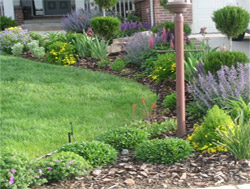
Fall Landscape Tips for Colorado!

Fall Landscape Tips for Colorado!
Fall is one of the most important times to care for your landscape. It is vital to ensure your lawn and trees have sufficient nutrients going into the winter season. Even though landscapes are going dormant, the root systems are still actively taking in water and nutrients. A mistake a lot of home owners make is turning off water too early.
Soil temperatures do not cool at the same as air temperatures. With this being said, root systems are still seeking water into November and even December depending on weather conditions. When you observe plant damage in the spring, a lot of time it occurred in the late fall and early winter months. Below are tips to help prepare your landscape for the winter months.
Lawn
- Cut
back your watering to twice weekly as long as high temperatures are remaining above 60 degrees. You will want to water fairly early in the morning and try to accomplish .75”-1” of water per week. The timing per zone will vary greatly depending on the type of heads and coverage you have with your irrigation system. - Water
monthly during the winter. You can use a hose sprinkler to accomplish this without turning on your irrigation system. Pay special attention to South and West facing areas since they are most prone to winter desiccation and Mite damage. - Fertilize
heavy in the fall to make sure your lawn has all the nutrients it needs to into winter dormancy. - Aerate
the lawn to allow more air, water, and nutrients to your root system, roots are developing in the fall, so this is extremely important. - Clean
up all the leaves from lawn areas, cut the grass short, and haul away debris fir the final mow of the season. - Winterize
or “blow-out” your irrigation system to prevent freeze damage. Early in the fall you can simply drain your backflow to prevent damage on cool nights. We usually don’t see the ground freezing until December.
Trees
- It is very beneficial to deep root fertilize your trees and shrubs late fall after they have begun to head into dormancy. If you use the right type to slow release fertilizer, you can have consistent feeding for up to 11 months.
- Prune back perennials and trees after they have dropped their leaves. Trees and shrubs will heal faster and have less of a “shock” factor when they are dormant pruned.
- Wrap maple trunks. Maple trees are extremely prone to Sunscald over the winter, so it’s important to protect the trunks.
- Water trees monthly. It is best to use a probe attached to your house and water the roots. Most trees will require 5-10 gallons of water monthly depending on how mature they are.
These are just a few tips on how to prepare your landscape for the winter months. Consult your landscape company and request an evaluation with recommendations to minimize winter kill in your landscape.
